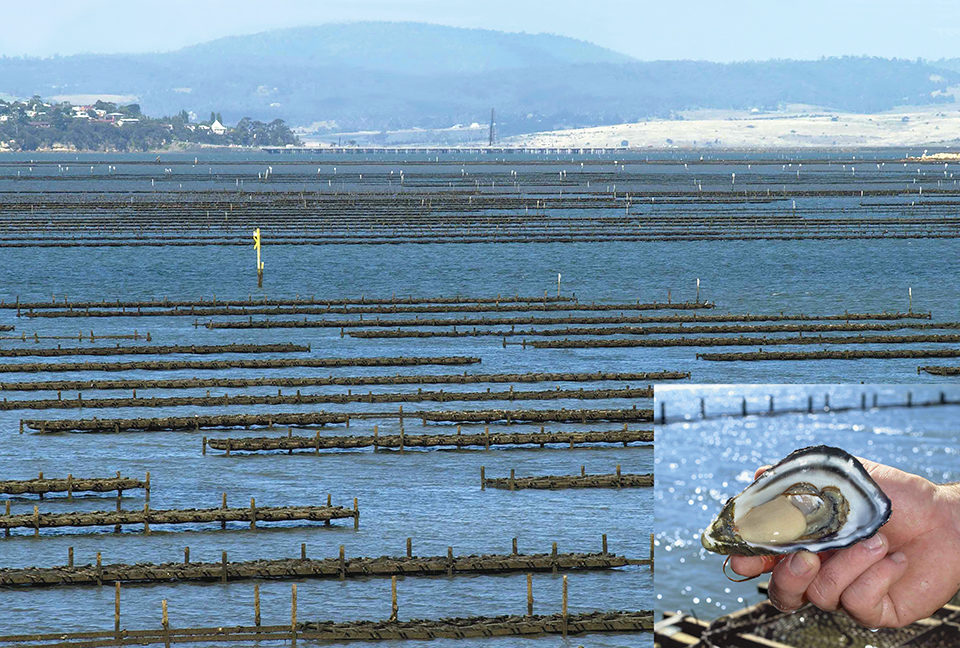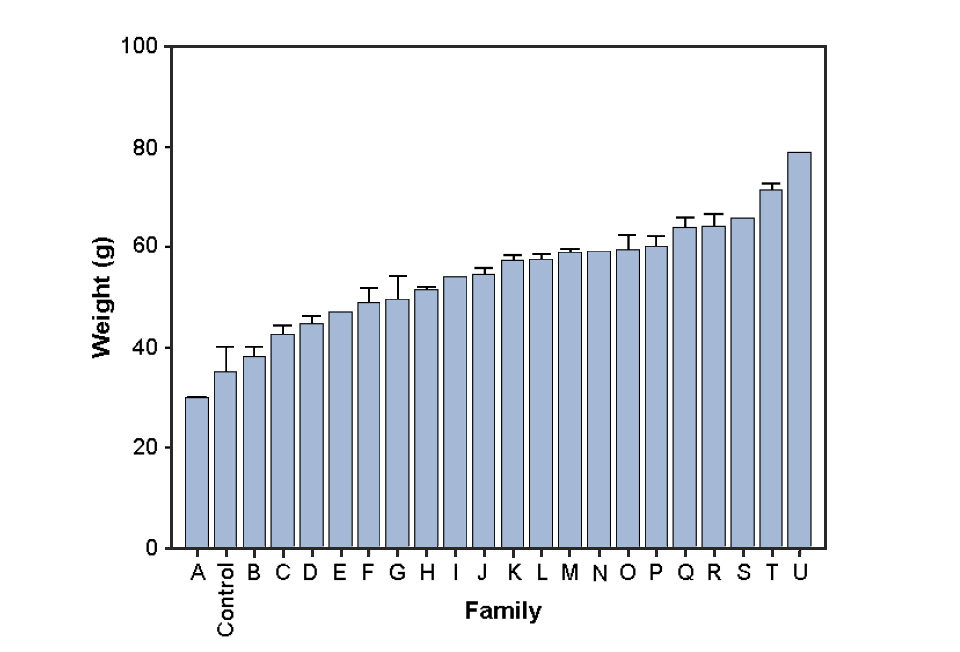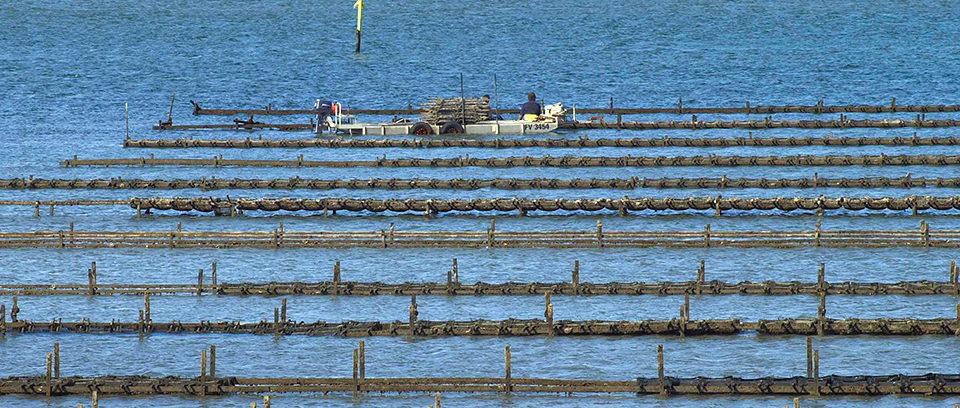Nonprofit Australian Seafood Industries responsible for 20 percent of spat sales

Considerable quantities of juvenile Pacific oysters (Crassostrea gigas) were brought from Japan to Tasmania, Australia, in the late 1940s and early 1950s to establish a new oyster industry, which had earlier been based on the local, slow-growing flat oyster (Ostrea angasi). Small populations of Pacific oysters were eventually established in some locations around the state, but the industry remained quite small until the development of hatchery technology.
Pacific oyster seed is now produced at several hatcheries and grown out around Tasmania, South Australia, and parts of New South Wales. Australian grow-out production of Pacific oysters – primarily intertidal in baskets on racks – is worth about AUS $30 million (U.S. $23.3 million) annually. The oysters are largely sold in the half-shell form.

Genetic variability
An assessment of genetic variability indicated no detectable difference between the Tasmanian population of Pacific oysters and the parental stocks in Japan. Commencing in 1997 with support from the Fisheries Research and Development Corp., a research team from the Commonwealth Scientific and Industrial Research Organization, University of Tasmania, and industry started a project to improve the breed. Mass selection with over 50 individuals per line, family selection, and inbred lines have all been part of the evolving strategy.
The challenges have been many, including working in remote locations, overcoming the logistics of rearing 50 separate families annually, and maintaining lines across five commercial grow-out farms spread over 1,500 km. The project also requires decisions about what traits and families to propagate, and developing a viable commercialization plan acceptable to all the participants.

Research
In the project hatchery, the 2 million fertilized eggs per line target was sometimes compromised by the experimental efforts to use 1-year-old broodstock. In addition, highly skewed sex ratios in some lines sometimes made it difficult to find the right sex from the right line for a particular cross. Screening off small larvae was minimized during larval development. After set, about 10,000 to 20,000 spat per line were randomly selected for the nursery. All subsequent reductions in numbers were random.
Within several months of spawning, approximately 5,000 individuals in each line were transferred to intertidal grow-out. Once they grew more than 6 mm, about 600 animals per line were delivered to each of five test farms. Four of the farms were intertidal and one was subtidal. The number of lines produced each year has varied. Some family lines were deleted due to poor performance or the presence of undesirable traits.
Improved traits
There has been a very significant improvement in growth performance for many of the selected lines relative to a commercial control line in each generation (Fig. 1). Performance assessment has focused on growth rate for the whole oyster, meat weight (both absolute and relative to shell), and shape. These traits have proven relatively easy to manipulate. Family lines have shown specific shell characteristics such as shape, most notably length and width (Fig. 2), “frill,” and coloration including hue and stripes – characteristics that are all highly heritable.
The more distinctive family lines are easily recognizable. The early focus was to find a high-performing generalist oyster to establish a line capable of performing well across a wide range of habitats and both intertidal and subtidal farming. Early in the project, some lines that showed promise as good generalists were trialed on an intermediate scale (10 million seed). The majority of oyster growers that tested the lines were favorably impressed.

Commercialization
To commercialize the results, the small company Australian Seafood Industries (ASI) was established in December 2000 by the major cooperative oyster industry bodies Tasmanian Oyster Research Council, South Australian Oyster Research Council, and South Australian Growers Association. ASI provides an important link between the Australian oyster industry, industry associations, and research agencies, particularly in relation to genetic research.
The nonprofit ASI makes thoroughbred broodstock available on request to hatcheries, which supply the resulting seed to growers at commercial rates. A small premium reverts to ASI to cover its costs. In 2004, the two major Australian hatcheries sourced a significant proportion of their broodstock though ASI.
Currently, some 20 percent of spat sales from hatcheries may be derived from ASI broodstock, a figure that will increase. Funds to continue the development of selected oysters will be derived from a levy on sales of the improved seed. Lines such as 118 from the F4 generation demonstrate considerable commercial advantages, including shape, consistency in growth, growth rates, and shell color.
In 2004, ASI produced the sixth generation of selected oysters and now manages all the experimental oysters and broodstock. The research team is completing the measurements of 2-year-old oysters produced in special experiments using 60 half-sib crosses designed to allow the estimation of heritabilities, finalization of the selection index, and recommendation of a long-term, sustainable breeding plan.
(Editor’s Note: This article was originally published in the February 2005 print edition of the Global Aquaculture Advocate.)
Now that you've finished reading the article ...
… we hope you’ll consider supporting our mission to document the evolution of the global aquaculture industry and share our vast network of contributors’ expansive knowledge every week.
By becoming a Global Seafood Alliance member, you’re ensuring that all of the pre-competitive work we do through member benefits, resources and events can continue. Individual membership costs just $50 a year. GSA individual and corporate members receive complimentary access to a series of GOAL virtual events beginning in April. Join now.
Not a GSA member? Join us.
Authors
-
Peter Thompson, Ph.D.
CSIRO Marine Research
GPO Box 1538
Hobart, Tasmania, 7001
Australia[32,117,97,46,111,114,105,115,99,64,110,111,115,112,109,111,104,116,46,97,46,114,101,116,101,112]
-
Bob Ward, Ph.D.
CSIRO Marine Research
GPO Box 1538
Hobart, Tasmania, 7001
Australia
Tagged With
Related Posts

Intelligence
Aquaculture has put the oysters back in Oyster Town
Whitstable Oyster Fishery Co. aims to safeguard the English town’s rich oyster tradition. Farming triploid oysters on racks in intertidal zones has made a "massive difference," says the company's managing director.

Responsibility
A helping hand to lend: UK aquaculture seeks to broaden its horizons
Aquaculture is an essential contributor to the world food security challenge, and every stakeholder has a role to play in the sector’s evolution, delegates were told at the recent Aquaculture’s Global Outlook: Embracing Internationality seminar in Edinburgh, Scotland.

Responsibility
A look at various intensive shrimp farming systems in Asia
The impact of diseases led some Asian shrimp farming countries to develop biofloc and recirculation aquaculture system (RAS) production technologies. Treating incoming water for culture operations and wastewater treatment are biosecurity measures for disease prevention and control.

Intelligence
A model for estimating pathogen variability in shellfish
This study reports on the development of a mathematical model for the shellfish depuration process and its impact on norovirus levels found in shellfish.


